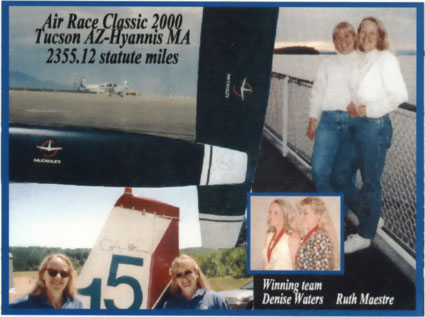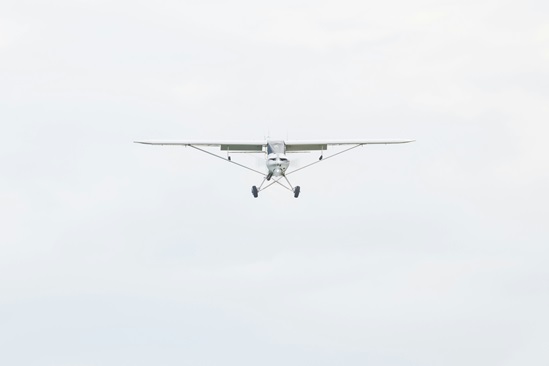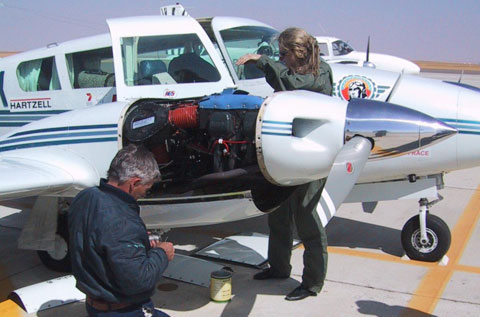
Flight instructors urge their students to learn as much as possible about the aircraft they fly. Denise Waters took that imperative to heart.
When Waters began flight training in the late 1980s, she decided the best way to gain knowledge of aircraft was to learn to maintain—or better yet, build—one. Now an A&P, light sport repairman (airplane), and commercial pilot, she has built her Express kitplane, modified aircraft for long-distance competitions and overwater marathons, and flown around the world. She is president of the Association for Women in Aviation Maintenance (AWAM), flies professionally, and has won the Air Race Classic twice.
Around the world in 180 days (or so)
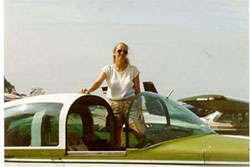 Denise Waters bought a 1979 Tiger to stay proficient while she was building an Express kitplane. She has since redone the panel and competed in multiple long-distance races.
Denise Waters bought a 1979 Tiger to stay proficient while she was building an Express kitplane. She has since redone the panel and competed in multiple long-distance races.
When a sponsor for her and co-pilot Ruth Maestre’s entry into a 2001 London-to-Sydney air race pulled out, Waters had to get another aircraft ready for the long journey—fast. She had the month of February (the shortest, coldest month, she noted) to turn a 1966 Piper Twin Comanche into a race-ready machine while Maestre earned her multiengine rating.
Between Waters and the maintenance shop, the Comanche got its annual, new Hartzell propellers, magnetos, and an updated panel. It got new ferry tanks, too: Even though the aircraft had enough range to make the overwater trips, the pilots were taking off in winter and didn’t want to take any chances. There was no time to install a new autopilot, so they hand-flew the whole way.
Waters and Maestre would fly to England for the start of the race and compete for nearly a month. The trip had special challenges of schedule and geography: Even before the race started, they braved winter in subarctic Goose Bay, Canada; and the race itself sent them over deserts and ocean. They arrived late and departed early, so it was a perpetual challenge to stay rested. “You don’t realize how much fatigue plays a factor,” Waters said.
Waters came to the race off of back-to-back wins in the Air Race Classic, but just finishing this race was an accomplishment, she explained: Of 30-some airplanes, one went down in the ocean on the way to the competition, killing the pilots; one went down in a sandstorm in the Middle East; one suffered damage from bad storms; another blew an engine in Singapore; and another spent a month and a half in Karachi, Pakistan, waiting for a magneto, she said. She carried extra parts on board the Comanche in case of mechanical difficulties.
The pair didn’t see much of the cities where they stopped, but they got a look at the restrictions many countries put on their airspace. When the teams departed from Egypt, the airport released one aircraft at a time, with 15 minutes of separation, she said.
“When you get back to the United States, it really makes you appreciate the freedoms we have in this country,” she said.
They considered selling the airplane in Australia when they arrived but decided against it: Waters ferried the airplane across the Pacific with New Zealand pilot Dee Bond, an official in the London-to-Sydney race whom she met along the way. (Maestre, an air traffic controller, had to get back to her job after the time off for multiengine training and racing.) Once back in the United States, Waters and Bond entered the Air Race Classic, continuing their journey from San Diego to Cincinnati. All told, she was gone about six months.
Full circle
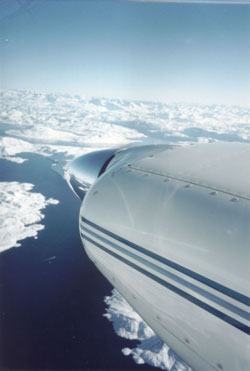 Waters and Maestre approached Greenland in the Twin Comanche on their way to the London-to-Sydney air race in 2001.
Waters and Maestre approached Greenland in the Twin Comanche on their way to the London-to-Sydney air race in 2001.
Waters’ parents met at an airport. Her father was a pilot and aviation mechanic; her mother soloed. But her career was never a foregone conclusion.
Her father couldn’t make a living in aviation and gave it up before she was born, so she didn’t really grow up around airplanes. She was intrigued by them, though, and did some gliding and hang gliding in upstate New York during high school--because she couldn’t afford lessons in powered aircraft.
She earned music education and performance degrees and entered a career in telecommunications before she returned to aviation years later. She finally had the money to fly something with an engine, so she started taking lessons. She was hooked.
“Once I started flying, I decided I had enough of the corporate world,” she said. She launched herself into aviation, studying both maintenance and piloting.
A New York City resident, she traveled to Teterboro Airport for training. She and her instructor used to fly over the George Washington Bridge to assess the traffic before the end of a lesson: If it looked bad, she’d stop for dinner before heading back to Manhattan.
Teterboro’s close proximity to New York City was convenient, but Waters found some of the aircraft rental restrictions frustrating. Shortly after earning her private pilot certificate, she decided she wanted an aircraft of her own.
“I thought about buying a plane,” she said. “And then I thought it would be a lot more fun to learn about a plane” while building it. She looked for a four-place kitplane for cross-country flying and found the Express, a low-wing, composite airplane. She started building it in Syracuse, N.Y., with help from her father. In order to stay proficient while she was building the Express, she bought a 1979 Gulfstream American AA-5B Tiger. Of course, she started working on that, too.
Ahead of the airplane
Waters said her experience as a mechanic and aircraft builder helps her as a pilot, too. “I think it lets me be just a little bit more ahead of the plane, or with the plane,” she said. For the many long-distance races Waters has flown, the ability to trouble-shoot and anticipate mechanical problems can be the difference between a short delay and a showstopper.
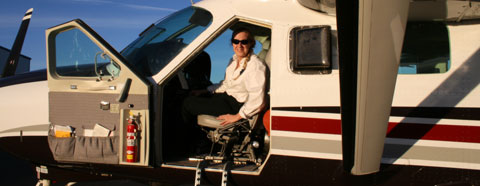
She recalled one time when her engine was running roughly and she finally had a bad magneto check in International Falls, Minn., at a field with no maintenance facility. She suspected a bad spark plug but had no tools to remove them to check, so she asked a mechanic at a corporate facility on the airport to check them for her. He confirmed that one was bad, but didn’t have any to replace it.
To the surprise of several pilots who were hanging around at the airport, Waters pulled out a spare spark plug.
“They were just amazed that I had it in my bag,” she said.
Now Waters flies a Cessna Grand Caravan to test onboard equipment, such as new pipeline leak detection technology and ADS-B. In the world of air racing, she has shifted from competing to serving on the board of the all-women Air Race Classic, a race she said she values because “you go back to the basics, so to speak” and because the race has a rich history. (It continues the tradition of the Powder Puff Derby.) The race is a learning experience for many women each year, and participants have reported finishing the event with a sense of accomplishment and increased confidence.
As the president of AWAM, Waters also offers support to women in aviation maintenance professions. Women make up only 6 percent of pilots, but the statistics for aviation maintenance are even lower—some estimates put it at around 2 or 3 percent.
“A lot of people come to me and they say, ‘What can we do to get more women into this?’” she said. By the time they reach college, it’s probably too late, she added. “You really need to start when they’re little.” She said AWAM helped start hands-on maintenance-related programs at the KidVenture section of EAA AirVenture in Oshkosh, Wis.; the program has expanded to include other organizations, and she said each year it introduces kids and their parents to the many opportunities in aviation.
Programs like that for young people, she said, show young girls—and, importantly, their parents and peers—that aviation can be a great career for women. “It shows them that there’s older women that are doing this, and that it’s acceptable,” she said.
